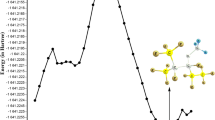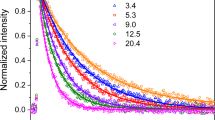Abstract
The products of the Cl-atom initiated reactions of a series of hydrofluorocarbons (HFCs) and hydrochlorofluorocarbons (HCFCs) in air have been investigated at 298 K and one atmosphere (740 Torr total pressure) of air. The products observed and quantified and their yields (%) were as follows: from CHF2Cl (HCFC-22), C(O)F2 (100%); from CHFCl2 (HCFC-21), C(O)FCl (100%); from CH2FCl (HCFC-31), HC(O)F (100%); from CH3F (HFC-41), HC(O)F (100%); from CH3CFCl2 (HCFC-141b), C(O)FCl (100%); from CH3CF2Cl (HCFC-142b), C(O)F2 (100%); from CH3CHF2 (HFC-152a), C(O)F2 (92%); from CHCl2CF3 (HCFC-123), CF3C(O)Cl (98%); from CHFClCF3 (HCFC-124), CF3C(O)F (101%); and from CHF2CF3 (HFC-125), C(O)F2 (∼100%). The reaction mechanisms are discussed.
Similar content being viewed by others
References
Anderson, L. R. and Fox, W. B., 1967, An unusual reaction of oxygen difluoride. The additional to carbonyl fluoride to produce bis(trifluoromethyl) trioxide,J. Am. Chem. Soc. 89, 4313–4315.
Anderson, J. G., Toohey, D. W., and Brune, W. H., 1991, Free radicals within the Antarctic vortex: The role of CFCs in Antarctic ozone loss,Science 251, 39–46.
Arvia, A. J. and Aymonino, P. J., 1962, Infrared absorption spectra of bis(monofluorocarbonyl)- and bis(trifluoromethyl)-peroxides,Spectrochim. Acta. 18, 1299–1309.
Atkinson, R., 1990, Tropospheric reactions of the haloalkyl radicals formed from hydroxyl radical reaction with a series of alternative fluorocarbons, pp. 165–205 inScientific Assessment of Stratospheric Ozone: 1989, World Meteorological Organization Global Ozone Research and Monitoring Project — Report No. 20, Volume II, Appendix: AFEAS Report, Geneva, Switzerland.
Atkinson, R., Baulch, D. L., Cox, R. A., Hampson, R. F., Jr., Kerr, J. A., and Troe, J., 1992, Evaluated kinetic and photochemical data for atmospheric chemistry: Supplement IV,J. Phys. Chem. Ref. Data 21, 1125–1568.
Cadman, P., Kirk, A. W., and Trotman-Dickenson, A. F., 1976, Reactions of chlorine atoms with ethane, propane, isobutane, fluoroethane, 1,1-difluoroethane, 1,1,1-trifluoroethane and cyclopropane,J. Chem. Soc., Faraday Trans. 1 72, 1027–1032.
Cox, R. A. and Lesclaux, R., 1990, Degradation mechanisms of selected hydrochlorofluorocarbons in the atmosphere: An assessment of current knowledge, pp. 209–231, inScientific Assessment of Stratospheric Ozone: 1989, World Meteorological Organization Global Ozone Research and Monitoring Project — Report No. 20, Volume II, Appendix: AFEAS Report, Geneva, Switzerland.
Edney, E. O., Gay, B. W., Jr., and Driscoll, D. J., 1991, Chlorine initiated oxidation studies of hydrochlorofluorocarbons: Results for HCFC-123 (CF3CHCl2) and HCFC-141b (CFCl2CH3),J. Atmos. Chem. 12, 105–120.
Edney, E. O. and Driscoll, D. J., 1992, Chlorine initiated photooxidation studies of hydrochlorofluorocarbons (HCFCs) and hydrofluorocarbons (HFCs): Results for HCFC-22 (CHClF2); HFC-41 (CH3F); HCFC-124 (CClFHCF3); HFC-125 (CF3CHF2); HFC-134a (CF3CH2F); HCFC-142b (CClF2CH3); and HFC-152a (CHF2CH3),Int. J. Chem. Kinet. 24, 1067–1081.
Hirschmann, R. P., Fox, W. B., and Anderson, L. R., 1969, The infrared spectrum of bis(trifluoromethyl)trioxide,Spectrochim. Acta 25A, 811–817.
Hoffman, J. S., 1990, Replacing CFCs: The search for alternatives,Ambio 19, 329–333.
McFarland, M., 1989, Chlorofluorocarbons and ozone,Environ. Sci. Technol. 23, 1203–1208.
Martens, G. J., Godfroid, M., Delvaux, J., and Verbeyst, J., 1976, Gas-phase hydrogen abstraction from asymmetrically halogenated ethanes by chlorine atoms,Int. J. Chem. Kinet. 8, 153–158.
Morgan, H. W., Staats, P. A., and Goldstein, J. H., 1956, Vibrational spectra of formyl fluoride and d-formyl fluoride,J. Chem. Phys. 25, 337–342.
Nielsen, A. H., Burke, T. G., Woltz, P. J. H., and Jones, E. A., 1952, The infrared and Raman spectra of F2CO, FClCO, and Cl2CO,J. Chem. Phys. 20, 596–604.
Niki, H., Maker, P. D., Savage, C. M., and Breitenbach, L. P., 1978, Fourier transform IR spectroscopic observation of chlorine nitrite, ClONO, formed via Cl + NO2 (+M) → ClONO (+M),Chem. Phys. Lett. 59, 78–79.
Niki, H., 1990, An assessment of potential degradation products in the gas-phase reactions of alternative fluorocarbons in the troposphere, pp. 235–248, inScientific Assessment of Stratospheric Ozone: 1989, World Meteorological Organization Global Ozone Research and Monitoring Project — Report No. 20, Volume II, Appendix: AFEAS Report, Geneva, Switzerland.
Prather, M. J. and Watson, R. T. (1990), Stratospheric ozone depletion and future levels of atmospheric chlorine and bromine,Nature 344, 729–734.
Rayez, J. C., Rayez, M. T., Halvick, P., Duguay, B., Lesclaux, R., and Dannenberg, J. J., 1987a, A theoretical study of the decomposition of halogenated alkoxy radicals. I. Hydrogen and chlorine extrusions,Chem. Phys. 116, 203–213.
Rayez, J. C., Rayez, M. T., Halvick, P., Duguay, B., and Dannenberg, J. J., 1987b, A theoretical study of the decomposition of halogenated alkoxy radicals. II. Fluorine extrusion,Chem. Phys. 118, 265–272.
Rowland, F. S., 1990, Stratospheric ozone depletion by chlorofluorocarbons,Ambio 19, 281–292.
Rowland, F. S., 1991, Stratospheric ozone in the 21st century. The chlorofluorocarbon problem,Environ. Sci. Technol. 25, 622–628.
Sehested, J. and Wallington, T. J., 1993, Atmospheric chemistry of hydrofluorocarbon 134a: Fate of the alkoxy radical CF3O,Environ. Sci. Technol. 27, 146–152.
Thompson, P. G., 1967,Bis(perfluoroalkyl) trioxides,J. Am. Chem. Soc. 89, 4316–4319.
Tuazon, E. C., Atkinson, R., and Corchnoy, S. B., 1992, Rate constants of the gas-phase reactions of Cl atoms with a series of hydrofluorocarbons and hydrochlorofluorocarbons at 298 ± 2 K,Int. J. Chem. Kinet. 24, 639–648.
Tuazon, E. C. and Atkinson, R., 1993, Tropospheric degradation products of CH2FCF3 (HFC-134a),J. Atmos. Chem. 16, 301–312.
Wallington, T. J. and Hurley, M. D., 1992, A kinetic study of the reaction of chlorine atoms with CF3CHCl2, CF3CH2F, CFCl2CH3, CF2ClCH3, CHF2CH3, CH3D, CH2D2, CHD3, CD4, and CD3Cl at 295 ± 2 K,Chem. Phys. Lett. 189, 437–442.
Wallington, T. J., Hurley, M. D., Ball, J. C., and Kaiser, E. W., 1992a, Atmospheric chemistry of hydrofluorocarbon 134a: Fate of the alkoxy radical CF3CFHO,Environ. Sci. Technol. 26, 1318–1324.
Wallington, T. J., Dagaut, P., and Kurylo, M. J., 1992b, Ultraviolet absorption cross sections and reaction kinetics and mechanisms for peroxy radicals in the gas phase,Chem. Rev. 92, 667–710.
Wallington, T. J., Ball, J. C., Nielsen, O. J., and Bartkiewicz, E., 1992c, Spectroscopic, kinetic, and mechanistic study of CH2FO2 radicals in the gas phase at 298 K,J. Phys. Chem. 96, 1241–1246.
Winer, A. M., Graham, R. A., Doyle, G. J., Bekowies, P. J., McAfee, J. M., and Pitts, J. N., Jr., 1980, An evacuable environmental chamber and solar simulator facility for the study of atmospheric photochemistry,Adv. Environ. Sci. Technol. 10, 461–511.
WMO, 1990a,Scientific Assessment of Stratospheric Ozone: 1989, World Meteorological Organization Global Ozone Research and Monitoring Project, Report No. 20, Volume I, Geneva, Switzerland.
WMO, 1990b,Scientific Assessment of Stratospheric Ozone: 1989, World Meteorological Organization Global Research and Monitoring Project, Report No. 20, Volume II, Appendix: AFEAS Report, Geneva, Switzerland.
WMO, 1992,Scientific Assessment of Ozone Depletion: 1991, World Meteorological Organization Global Ozone Research and Monitoring Project — Report No. 25, Geneva, Switzerland.
Yano, T. and Tschuikow-Roux, E., 1986, Competitive photochlorination of the fluoroethanes CH3CHF2, CH2FCH2F and CHF2CHF2,J. Photochem. 32, 25–37.
Zellner, R., 1990, Atmospheric degradation mechanisms of hydrogen containing chlorofluorocarbons (HCFC) and fluorocarbons (HFC), pp. 251–266, inScientific Assessment of Stratospheric Ozone: 1989, World Meteorological Organization Global Ozone Research and Monitoring Project — Report No. 20, Volume II, Appendix: AFEAS Report, Geneva, Switzerland.
Author information
Authors and Affiliations
Rights and permissions
About this article
Cite this article
Tuazon, E.C., Atkinson, R. Tropospheric transformation products of a series of hydrofluorocarbons and hydrochlorofluorocarbons. J Atmos Chem 17, 179–199 (1993). https://doi.org/10.1007/BF00702825
Received:
Revised:
Issue Date:
DOI: https://doi.org/10.1007/BF00702825




